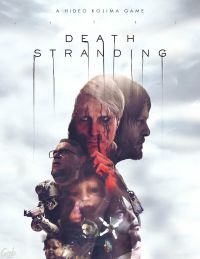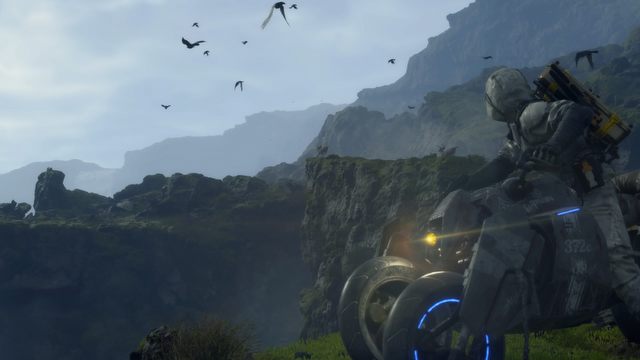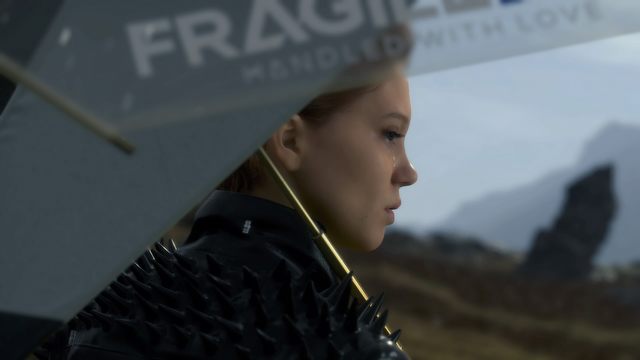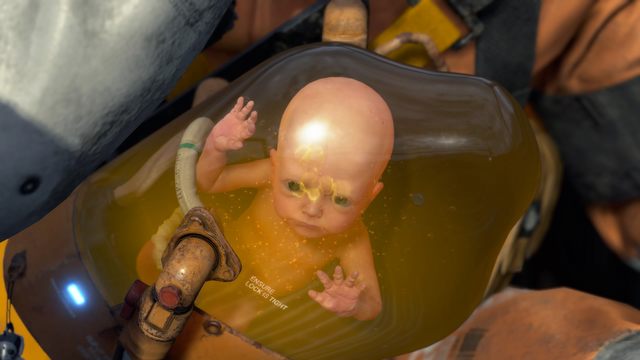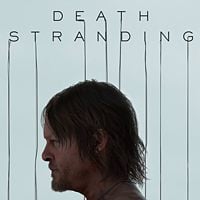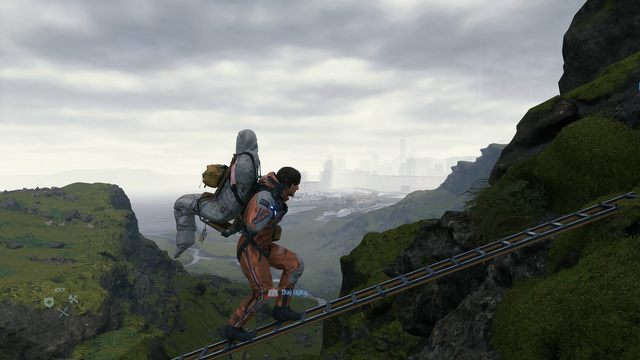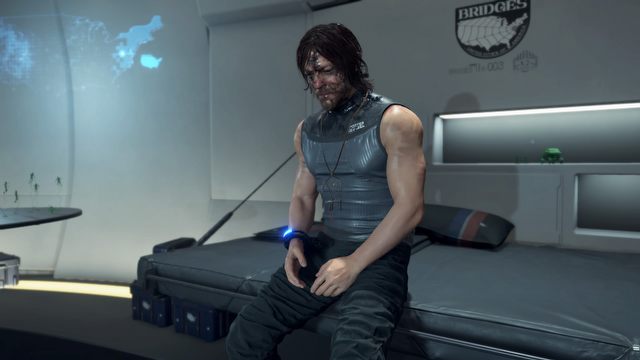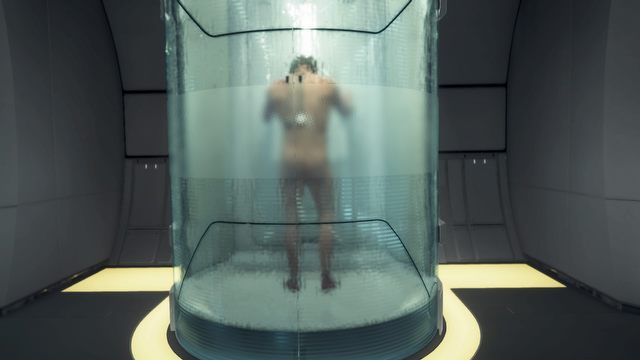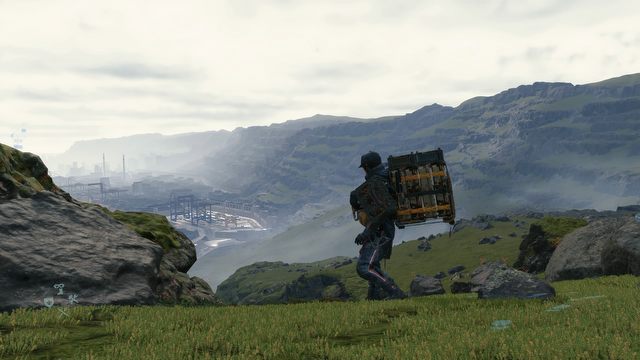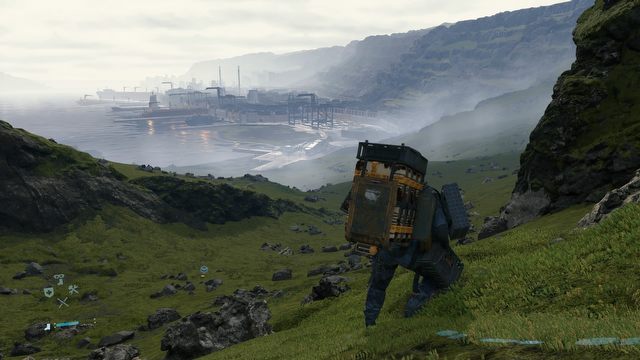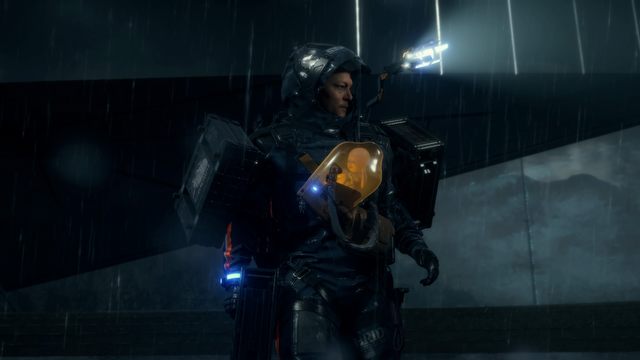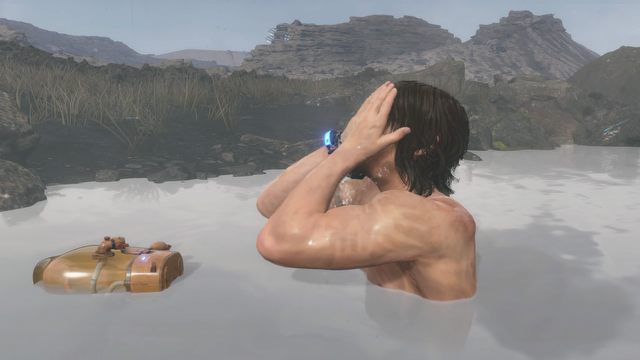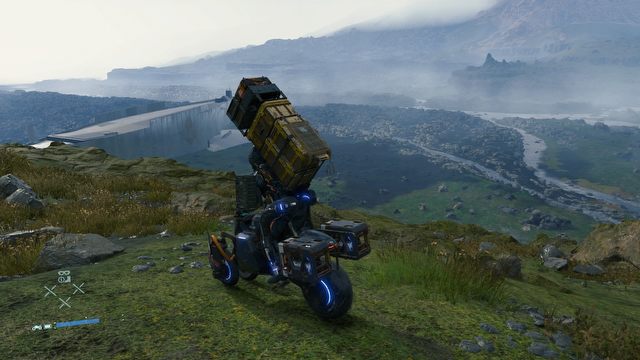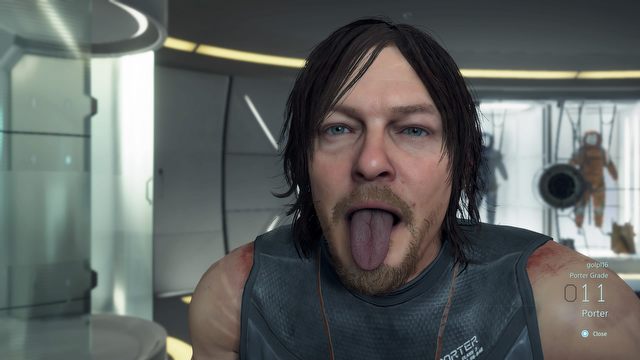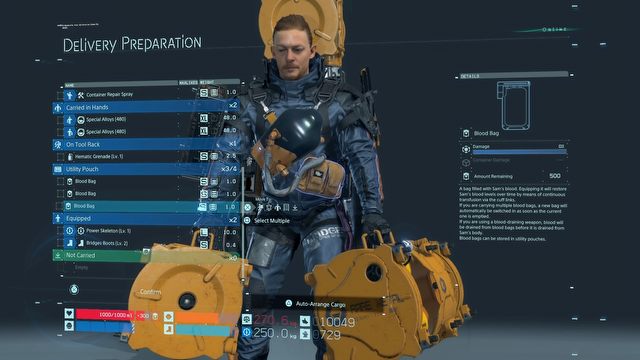Death Stranding Review – A Long Walk with Kojima
It took me 3222 minutes to finish Death Stranding. That was fifty hours of enchantment with slight shades of consternation. But all the while, I felt that Hideo created something that defies all the traditional rules of electronic entertainment.
The review is based on the PS4 version.

When it was announced in 2015 that Hideo Kojima is parting ways with Konami, leaving behind the Metal Gear Solid series, I couldn't help but feel that the industry has reached the end of a chapter – a chapter that also was a big part of my own life. We would never play a new Metal Gear Solid again. Let's crack open the bottle, raise a toast in memory of the great series, and all the feels it gave us from 1987 to 2015 – that sort of thing.
Jump to 2016, the E3. Andrew House, then CEO of Sony Interactive Entertainment, invites "one of the most creative minds in gaming history" to the stage. The lights go out, the curtain opens – a silhouette steps down the stairs that light up gradually. Hideo Kojima enters and says: "I'm back." A few moments later, everyone loses their mind with the first trailer to Death Stranding, which shows a naked, crying Norman Reedus on a beach, hugging a newborn baby. And we all knew: "Ah sh*t, here we go again."
REMEMBER: NO SPOILERS
We won't reveal any vital plot details here. For the purpose of the review, we will only discuss an outline of the story. We will not even describe all the gadgets, so as not to spoil the fun of discovering them yourself.
A 50-hour experience
- graphics, landscapes and detailed models – Decima still delivers!
- the songs selected by Kojima, performed by Low Roar and Silent Poets, will turn you into a whimpering mess;
- the grim vision of a dystopian apocalypse is among the greatest settings you will see in any video game;
- idiosyncratic story full of twists, absurdities, lies, pop-culture tropes, and sentimental feels;
- cinematic shots and fantastic presentation of the main figures of the story, played by real characters;
- the moment I can't tell you about because of embargo on stuff past Chapter 3;
- a well-designed and entertaining multiplayer module!
- if you just play to learn what it's about, it may be too long and monotonous;
- a difficult storyline that doesn't like revealing secrets;
Completing Death Stranding took me 53 hours, 42 minutes and 51 seconds. 3222 minutes. 197 kilometers. 3.5 metric tons. That's what the game told me after I completed it. Do I feel enriched? Well, I feel I've completed a game that's engaged and valuable. One that gives you a good argument to ponder: is Death Stranding more art, or entertainment? Does the plot fall victim to pretense and the kitsch? Doesn't repeatability kill it? And, perhaps most importantly, did Kojima manage to convey the message he intended?
You will certainly find yourself asking these questions on many occasions when playing Death Stranding. And you might just find that the criteria you'd been using to evaluate games are insufficient. Because the meaning of this game, its mechanics, gameplay and plot, defy the usual set of rules. Think of it this way: you can appreciate the game's graphics, plot, or mechanics. Write it down even. And then try telling your friend about it. And they'll still probably ask: "But what is it all about?"
Death Stranding is not a difficult game, but a very difficult, thoroughly personal experience. This realization comes early, as you climb down a hill, watching the barren, Icelandic landscape open in the distance, hearing the song from Low Roar in the speakers. I'm convinced that most reviews of this game will include the slightly puffed-up phrase "not a game for everyone." That's true. And I'll try to tell you why.
A brief history of the world, or how I became a cable TV technician
Sam Bridges (played by Norman Reedus) is a courier. He carries packages and delivers vital resources. He's quiet, reticent, and he shuns people. He suffers from haphephobia – fear of touch, so you get why he's not the most sociable guy on Earth.
The post-history Earth. When we first get to know Sam, he lives in an empty and uninhabited world (not counting the occasional bandits). No more cities, no more roads. Not villages nor shops. Not even shopkeepers! No one does anything – at least at first glance.
There is no time reference, and it makes sense – geography is no more, the world has no history. We know a world order used to exist (historical, cultural, political, etc.), but a few decades ago, the eponymous Death Stranding occurred, which erased all cohesion, knowledge, and history. Death. Invisible creatures invaded our world. Ghosts with umbilical cords commenced global annihilation. Those who survived, built shelters. Today, people are born and raised underground, and only "see" the Sun and the sky, when after death they're transported to the surface.
Sinister spirits, demons, or beings from another dimension appear along with temporal precipitation – the timefall. This is no ordinary rain – it accelerates time, and, as a consequence, entropy. Steel completely rusts and people age in a matter of seconds. The only way to escape is to hide deep underground. Those who hadn't managed, perished in powerful explosions. Only huge craters remain, like after nuclear blasts.
Any death, even from natural causes – brings about these explosions, and the arrival of the ominous creatures. Therefore, an incinerator was established, where the remains of the dead are burned in furnaces – far from underground cities. For the same reason, the society has been divided into dozens of small groups that have no contact with each other, and the courier is the most respected profession. They're among the few people connecting the islands of humanity.
We begin the game when the former employers of Sam, the Bridges organization, contacts him. We know we used to work for the company, but the reasons for Sam's parting with them aren't clear. Finally, he accepts their proposal – Sam is entrusted with a huge undertaking: to go from the East to the West coast of North America, along the way establishing a network that could reconnect the fragmented population and allow the rebuilding of the nation. Sam takes the job not because he's particularly patriotic, but because his childhood friend had been kidnapped. And so, in addition to being a courier, he also becomes a cable TV technician, and goes West to reconnect people.
ALL RIGHT, BUT WHAT'S UP WITH THE BABY?
Along the way, we get a hold of a baby in a portable incubator, who will henceforth be our companion along the journey. These are called the Bridge Babies. These babies are able to warn people of the impending death and the invisible evil. Together, we stand a chance to cross America – Sam is one of the few (maybe the only one?) repatriate – a person who resurrects after death. Kojima's at it again, in other words.
How does it play?
Contrary to popular belief, the game's rather straightforward. Underground terminals offer jobs, such as wood delivery – we can accept it, and then we hit the road. Yep. This game is the definition of "taken aback." "You mean I'm supposed to just carry cargo from place to place? To be some sort of Internet provider for the people?" That's exactly what I mean, and this is the game's most fundamental premise, in gameplay terms. Death Stranding is simply a road game. You walk. Then walk some more. March. In Death Stranding, this is the main thing you do.
Kojima Productions has developed very extensive movement mechanics. Each piece of cargo has its own weight and size. There's a few slots to put them into: on the back, legs, arms, and hands (as well as – after unlocking various gadgets – on drones and different vehicles). The player not only has to make sure Sam is able to carry the total weight of the cargo, but also that it's distributed evenly across his body (protip: press the triangle and the game will do that automatically) – otherwise his movement will become cumbersome.
That's not all, because if that happens, you can also use R2 and L2 to balance the body. You might think that these "gimmicks" sound fun on paper, but probably become nuisance after 30 minutes. Well, Billy – not really. If Sam starts to waver, it means one of three things – he's carrying too much, you've messed up weight distribution, or he's growing tired and needs to rest. I had really no complaints, when I assaulted Sam with 90 kilograms of stuff, and he ended up constantly tripping – rather than a nuisance, this introduced a level of coherence and realism rarely seen in games.
There of course is a stamina bar that gradually depletes, and the ratio depends on how much you carry, what's the environment, and what shoes you wear. There also are numerous hidden mechanics at play here, such as momentum. If you've ever walked downhill and felt you can't stop – you know what momentum is. So this game has that. Ever went hiking and wondered which trail to choose so that you're not exhausted after four miles? You will do that here. Have you ever crossed a river without a bridge? If you have, you will know it's not an easy task, especially when you're carrying a heavy backpack. The rivers in the game are quite an adventure – and they'll punish you for casual (perhaps conditioned by other games), careless attempts at crossing them. So be careful, you don't want to lose cargo.
You will also use a variety of gadgets that will be indispensable along the way – ladders, ropes, and things that make traversing difficult terrain easier. Of course, each of these items has its own weight, too, so each expedition requires special preparations. You can't take fifteen ladders with you and cross the Grand Canyon just like that. We've got to think and ask good questions – where to place the ladder, which way is the best, do I need it on the way back, etc. Each gadget or weapon you take also means there's less cargo you can carry. So choose wisely.
Beached Things
The encounters with the BTs are horrifying. It becomes dark, it starts to rain, and the uncanny atmosphere is exacerbated with unsettling soundtrack. The scanner on our arm goes off and crazy, and the baby in the jar starts crying. The only way to avert the threat is to stand still. The creatures react to sound, so we need to hold the breath if they come close. We don't know what they are, whether they have any motivation or intelligence. What we do know is that we're better off without them getting too close.
Especially in the beginning, it's really scary. There's no way to harm them, and avoiding them on slippery surfaces with so much cargo on the back isn't easy. It's pretty intense when we the prints on the ground reveal something's coming our way, especially when you add the soundtrack.
The "lions" you might have seen on trailers appear when Sam is compromised. The world is flooded with black tar, and a huge creature is trying to devour him. The first encounters with them are moments when we alternate between feelings of horror and astonishment. Graphically Death Stranding is simply dazzling. The black substance flooding the world breaks trees, and even if we're in the mountains, it won't stop it from reaching the very summit. During battles – later in the game, we will be able to fight these creatures – we will see buildings and old cars emerge from the black resin – evidence of a world that no longer exists.
Camera – action!
This is not an action game – shooting in Death Stranding is residual. I would even forget to take any weapons with me on numerous occasions. Sam Bridges is no commando, or a secret agent. He's a courier who delivers parcels. The game ends up giving us some weapons to toy with, but in truth, we rarely have the opportunity to use them – at least in the first chapters of the game. The only entities we encounter are the BTs, which we cannot fight, and bandits.
We can eliminate the latter in open combat, or silently (the bolas launcher, a weapon demonstrated on trailers, able to incapacitate the enemies, works great). Sneaking, however, does not come natural to a courier carrying large cargo. The bandits also have scanners that can reveal our location (more precisely, the location of our inventory) from a few hundred meters, so sneaking into the camps isn't as easy as in Metal Gear Solid. Combat itself isn't very compelling. We can take on an entire group of bandits with nothing but bare fists, and once we get a hold of a weapon, we're practically unstoppable.
However, there is no apparent reason why we should visit these camps at all – of our own bat. The only incentive to go to these places are occasional collectibles and a ton of resources that we can use to build bridges, generators, hideouts, and many other, useful buildings. But then, the resources can be obtained in the base, or found in other places. This is not a Ubisoft sandbox. You won't be attacking forts, unlocking towers, or clearing dozens of camps of enemies.
Death Stranding is not about combat, and if you are looking for that in the game, you won't be happy. You spend most of the time on the road, traversing rivers and mountains, climbing and figuring out fastest and safest routes. If there's one thing that I found truly awe-inspiring, in this game, it would be the loneliness. The atmospheric music of Low Roar and Silent Poets only deepens the feeling of experiencing something extraordinary.
You will be walking for miles and then resting, hiding from the deadly timefall in caves and cracks. You will setting up ladders over violent torrents and precipices, and use ropes to descend safely from heights. If you spot an abandoned package, you have to figure if it's worth risking getting fifty meters down to collect it. Ever experienced something similar in another game?
I know it may no sound very exciting, but I can assure you it actually is. And then, did you expect anything else after the trailers and previews? This is Hideo Kojima after all – you love him, or hate him. For some, he is a dreamer, for others, an utterly pretentious and overrated creator.
Death Stranding is similar in reception as Metal Gear Solid was years ago. It is a game, that's at once strange and beautiful – exaggerated, but also monotonous. If you liked the freak ideas in the Japanese creator's previous games, then his new game should please you as well. What's it like inside your head? When games are trying to abandon fetch quests, Kojima creates a game that's completely based fetching quests. This alone may not be particularly extravagant, but remember that the game also features babies in jars, and you can throw grenades with urine and feces at some invisible creatures.
Lonely multiplayer fun
The online aspect deserves high recognition. Leaving marks for other players, known from the Dark Souls series, and Bloodborne, has evolved into a truly essential system that's fun and can really save the day.
We can not only leave all sorts of marks for other players to find in their worlds (they provide bonuses to stamina and the baby's attitude). If we leave a ladder somewhere, then a player who has already unlocked the network in the given region, they will be able to use it. Things are similar with hideouts, shelters, and generators that power our vehicles – we can use the buildings of other players, which can be extremely helpful. I can't count how many times I've used a rope left by someone else (generously rewarding them with likes) or a shelter. I myself left a bridge in a strategic location, and soon received information that someone, somewhere out in the world, used it during their own campaign. Nice!
MY JOB IS HELL
During my playthrough of Death Stranding, I went to work every day. My colleagues constantly asked me questions. Apart from the regular "what is it about?" and "isi it good?" I was also asked the following:
- Can we pee on the tire?
- Can we piss on humans?
- Can we piss on the cargo and then put it on our back?
- Can we draw with urine?
- Can we pee in the hot spring and then take a bath?
Dear readers – now you know sort of people create this website for you every day. I am sorry. And no, I will not answer these questions – see for yourself!
If you are tired of constantly making your way through difficult terrain, you can build roads (in some places, not just anywhere we wish). Building them, however, requires a huge amount of raw materials, so players end up crowdfunding it. If you can manage to do it, you will complete the road and be able to travel on a bike, which makes completing side quests much easier.
Moreover, if you happen to lose a piece of cargo on the way, other players will see it in their world. They can pick it up and deliver to the destination. If you're missing an item, check the repository containers, where players store the items they don't need, before spending resources on crafting. We can share everything, from gadgets, to roads, bridges, and vehicles. Thanks to this, backtracking – and there's a lot of it – becomes bearable. Once we activate the network in an area, we can move around faster using upgrades and other facilities.
I was also happy about something I didn't see in the game – the micropayments. Which is nice, because there's a ton of elements that could be sold for real money. Like the holograms that appear next to your buildings.
Paycheck in likes
And now the best thing: you do not get paid for your courier work. You cross dangerous lands invaded by sinister creatures with weighty cargo during a deadly rain, and you don't get a penny for it. You get a likes. Yes, the same kind of likes you get in social networks. A form of kudos that has no tangible value. Stupid? Of course!
But think about it: this is a world without nations, nothing to trade, there's no market, even a black one, and the people, stranded in shelters, have no currency – what else can they offer?
Only their gratitude. The like. A twisted, detached way of showing gratitude in a virtual world becomes the only currency. Just imagine: how dismal is a world, in which the only currency are exactly "likes"? What did we do to deserve such fate? Kojima repeatedly points that Death Stranding is a critique of the modern world.
There are many ways to interpret the game: for some, it will be a quasi-science-fiction, spiritual story about the end of history. Others – and I've found myself among them – will notice how strong an ecological message is conveyed here. I don't want to start harassing you with notions of sin and penance, but when playing Death Stranding, you will find numerous traces that will allow your own interpretation of the game. Right, interpretations – Death Stranding, like no other game, is prone to interpretations.
Movie or game?
The Death Stranding experience consists of a few stages. You will wonder and admire it. You will search and try to understand. But you will also be disappointed, constantly asking yourself the question: is that it? Is this the game? Walking? Do I have the honor of experiencing something truly important, am I just a victim of deception?
For me, true crisis came in Chapter 3, when I realized that not much will change anymore. That I've pretty much seen the entire game. Lots of walking, carrying cargo, some cut-scenes and combat. And if the plot isn't good, nothing will save this game. You see, Death Stranding keeps us engaged with a promise – we want to know what's really going on, who's who, why the ghosts roam the world, how is Sam Bridges involved, and what's the deal with the babies in jars? Seduced by the perversion of that promise, we go through most of the game realizing at some point that no one is eager to tell you anything. The composition of the game – verbose, long and monotonous – has its drawbacks, no doubt. But in the end, I think Kojima gets his way. I fall for these secrets, roaming the cavernous and sad world of Death Stranding.
Fortunately for you and me, Kojima surprises us again with a warped, complex, and strange intrigue that has room for absurd, fantastic characters. I can't tell you much about them without revealing things that are real fun and satisfying to discover. I will only tell you that I was constantly looking forward to see new cut-scenes, and Heartman (Nicolas Refn, a director of some fine movies like Drive and Valhalla Rising) is one of the most interesting characters of all the crazy figures invented by Kojima. And Mikkelsen. Don't forget Mikkelsen – all I can tell you is that he's fantastic.
You may remember the line of criticism of the games featuring the famous Snake – "it's not a game, it's a movie," they said. Honestly, there's not that many cut-scenes in Death Stranding. There are times when we actually miss them. Int terms of composition, the game reminds me of Phantom Pain, which for some will be a great advantage, and for others (including me) not that much.
In each of these cut-scenes you can see the deep and irresistible affection the father of MGS has for movies and cinema. The shots are gorgeous, the moments tug the heartstrings and leave us jaw-dropped. I will not be surprised if Hideo makes a movie of his own one day.
Paradoxically (because this game really is the art of paradox) this strange and secretive story is one of the greatest advantages of this game. Even if not everything is clear and straightforward, and some moments are stepping on thin ice of pretentiousness and kitsch, in the end, Kojima leaves us satisfied. And I can't wait to start watching analyses and interpretations of the game and it's story, which I'm sure will flood the Internet soon. Believe me, there's plenty to argue about.

SECOND OPINION
Despite a few minor blemishes, and poorly executed ideas, Death Stranding has exceeded my wildest expectations – it's a surprisingly successful experiment that proves that even with a "courier simulator," Kojima can deliver an exciting and compelling game, with an original and intriguing world, memorable characters, and a thrilling, touching storyline that also has something important to tell us. Sony, give this man all your money, let him never stop making games.
My rating: 9/10
Jordan, Gamepressure Editor
A Hideo Kojima game directed and produced by Hideo Kojima
I don't know if there is another ego like his in the electronic entertainment industry. Kojima's autorealisation is a completely new phenomenon for the industry, and I can understand people who don't applaud it. How much of that is done for marketing purposes, how much for the true need of authenticity, and how much just for kicks? It's hard to tell. But there's one thing you can't deny: he has his own, very recognizable, quirky style, and if I did not know that Death Stranding was directed by Hideo Kojima, I would be able to tell after playing it for 10 minutes.
I grew up on this weird, ambiguous and diverse style, which accommodates evidence of war, bisexual vampires, bipedal robots imitating cow sounds, cybernetic ninjas, and Soviet psychopaths armed with portable nuke launchers. And this game brought me just as much joy and delight as the ending of the third part of Metal Gear Solid. If you believe Hideo Kojima – if you accept the shortcomings of his worlds – then Death Stranding will be an experience that will knock you out of your comfort zone for a long time.
It's a game that Hideo Kojima wanted to create, and it looks like he's poured a lot of his own, twisted character into the lines of code. And that's very good, because Death Stranding is one of the most beautiful and, at the same time, one of the scariest worlds I've visited in games.
ABOUT THE AUTHOR
I've played about 53 hours of Death Stranding so far. The game can be completed in about 30+, but I've just had so much fun exploring this world, doing side quests, or just buildings things. I've been playing Hideo Kojima's games since I was a kid, I've been through every major part of Metal Gear Solid (completing some of them several times), and I one of those people who totally believe his absurd world and can swallow his gameplay peculiarities. I consider Metal Gear Solid 3: Snake Eater to be his opus magnum.
DISCLAIMER
We received a review copy of the game from Sony free of charge – big up.
Death Stranding
Death Stranding Review – A Long Walk with Kojima
It took me 3222 minutes to finish Death Stranding. That was fifty hours of enchantment with slight shades of consternation. But all the while, I felt that Hideo created something that defies all the traditional rules of electronic entertainment.
